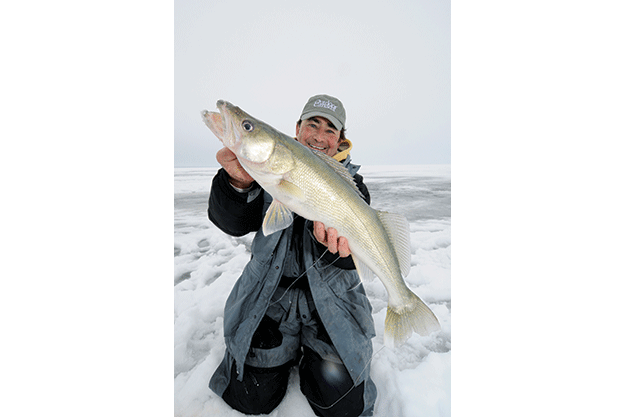Advertisement
Where to find ’em
I’m fortunate to live in the heart of winter walleye country, with scores of great lakes. On remote, low-pressured waters with scads of structure in the form of points, bars, reefs and saddles, I can often catch walleye on the same spots during all three winter stages.
Advertisement
That’s not the case, however, on the more popular lakes where ice-fishing pressure takes its toll by mid-winter. And at the same time, the February doldrums arrive and walleye—as well as most other fish species—go into their mid-winter funk.
When this happens, I compensate by searching for the smallest, least-obvious structures that the crowds overlook. I also have a cheat sheet of such out-of-the-way locations stored in my GPS unit, making it easier to pinpoint the sweet spot-on-the-spot that every structure offers. It could be a subtle, isolated patch of gravel, or several boulders lying on top of one another that distinguish the point, bar or reef from everything else around it.
If you don’t have a cache of isolated structures to plunder in mid-winter, however, and you’re forced to rub elbows with the masses on community holes, don’t despair. Locate the prime sweet spot—every structure has one—and go fishing during the twin peak periods of first and last light. This is especially true if you’re ice fishing in a crystal-clear walleye lake.
Advertisement
As keen anglers know, walleye are highly sensitive to light; it’s the change in light level that takes place during the 90 minutes surrounding sunrise and sunset that triggers the fish to feed aggressively. And of these two periods, the evening transition is hands down the most productive for fishing.
As for shallow, structure-free, bowl-shaped lakes where walleye seek out deeper pockets and holes, they’re at their best in mid-winter. At first ice, not all of the fish have moved into the depressions—it’s more of a gradual filtering-in process. By mid-winter, however, every walleye in the lake will have gone to the deep spots.
Advertisement
Just remember to exercise restraint and understand that you’re fishing over a huge concentration of the lake’s walleye population. You can easily fool yourself into believing the supply is endless, but it isn’t. Fortunately, these vulnerable shallow-water fish are easy to release unharmed, which is particularly important when it comes to the large, egg-laden hens.
How to catch ’em
In small pockets of deep water, traditional flash lures, search baits and jigs tend to work the best. On vast, featureless seas such as Lake Winnipeg and the Bay of Quinte, however, mid-winter is the prime time to shake, rattle and roll, using loud, vibrating, lipless crankbaits to attract and trigger the fish. These baits pay off particularly well when you set up a deadstick rod over a second hole immediately adjacent to your jigging hole.
The benefit of jigging a lipless crankbait is that the walleye will easily see it and hear it, and rush over to investigate. When the fish are particularly aggressive, you can actually watch them streak across your sonar screen and feel them smack your lure, either on the pause after you lift up the lure or after it falls. And the strikes are uncharacteristically vicious for walleye.
At other times, though, you’ll see a fish rush across your sonar screen, inspect your lure and refuse to strike. You can entice at least 75 per cent of these lookers to bite if you also have a light (1/8- to 3/16-ounce) jig tipped with a lively minnow, salted shiner or scented soft-plastic minnow hanging a foot off the bottom, only a couple of feet away down a second hole. It is a deadly one-two combination.
Of course, the same set-up also complements flash lures and horizontal search baits, which is why I nearly always drop a jig down my second hole. But the presentation truly excels when you’re jigging a noisy lipless crankbait.
On these expansive, generally featureless waters, I typically rely on my GPS unit to run-and-gun high-percentage sweet spots, looking for the nomadic tribes of big walleye that are constantly stalking schools of pelagic baitfish. And when I jig lipless cranks, the biggest fish I’m likely to catch at a particular spot is usually the first one up the hole. I don’t know why that is—it’s just the way it normally plays out.

